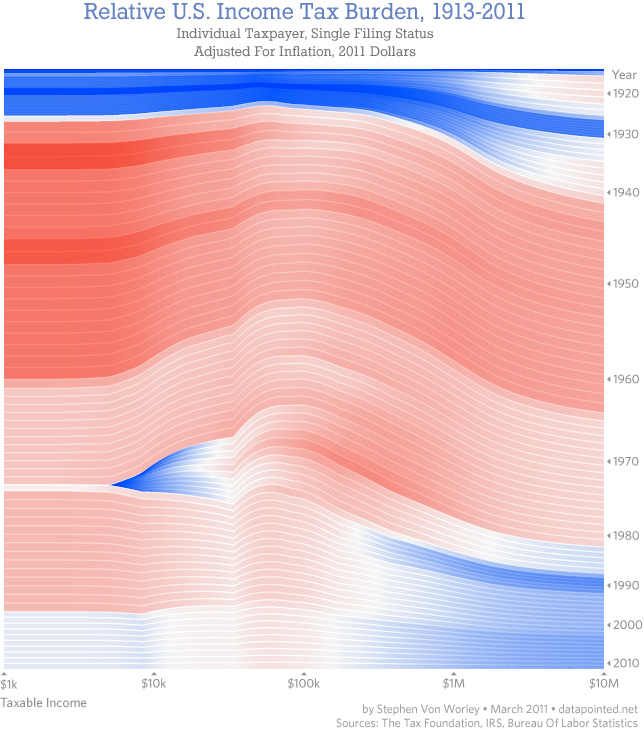The tax man cometh, and to illustrate the inequities of his cleft-hoofed embrace, we’ve charted the shift in U.S. income taxes from rich to poor over the past century:

That’s a line for every year from 1913 onward, sized and colored by the tax burden: the amount of tax due relative to the long-term average at each income level. Above-average burdens appear thick and red and below-average thin and blue. We adjusted everything for inflation to ensure an apples-to-apples comparison, with the caveat that the effects of Social Security, Medicare, and other taxes are not included. The underlying data comes from The Tax Foundation, IRS, and Bureau of Labor Statistics, and is the same information we used in last year’s bracket graph, updated for 2011.
Our graph shows a series of tax regimes. Overall, taxes stayed low until 1940, spiked during World War II, remained high through the Korean conflict, and eased slightly in the mid ’60s. From there, they held steady, until President Carter emancipated poverty-level wagemakers with his tax-free under-$8000 bracket, creating the blue wedge in our graph. Three years later, Reagan entered office and began turning the tables, finishing in 1988 with his retrograde 28% upper rate. The rich were now on tax vacation, at the expense of the poor and middle class.
A modified Reagan-era tax system lingers to this day. To his credit, Dubya did reduce taxes on very low earners, so they’re no longer getting hammered. But, the people at our economy’s core – the full-time workers earning between $20,000 and $150,000 a year – still pay at up to double the rate of the ultra-wealthy, relative to what history suggests they should.
About this, I’ve got mixed feelings. More than a few of my friends have hit the dot-com-Web-2.0 jackpot, and every spring, they enjoy a fresh tax windfall. And why not? They worked hard, created value, got paid, and dadgummit, isn’t that what capitalism is all about?
On the other hand, so that the American Dream doesn’t degenerate further into a have-or-have-not nightmare, perhaps some social pragmatism is in order. Via a small dose of fiscal self-sacrifice, the fat cats can maintain their grip on the reins. Or, they can stay the course – and keep on partying like it’s 1999 – until an angry mob bursts through the front door, drags them down to the town square, and lops their wealth off.